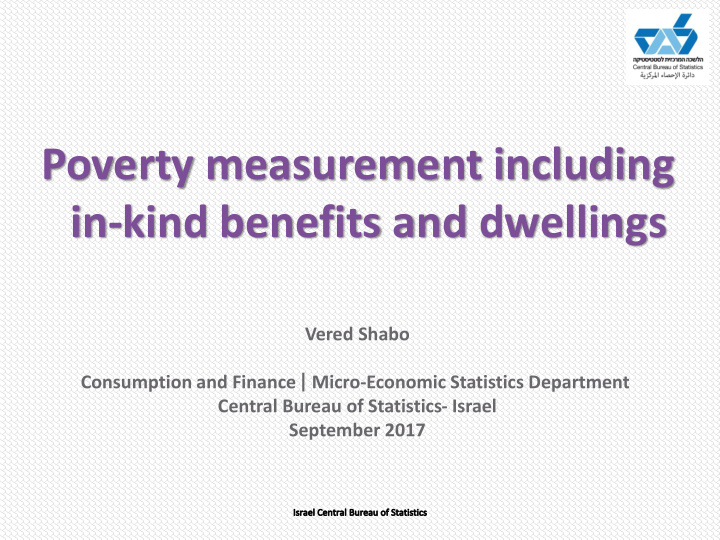



Poverty measurement including in-kind benefits and dwellings Vered Shabo | Consumption and Finance Micro-Economic Statistics Department Central Bureau of Statistics- Israel September 2017
Poverty based on disposable income per standard person - (X) In Israel, the measurement of poverty is based on the relative approach. The poverty measurement is based on three principles: 1. Disposable income 2. The poverty line 3. Adjustment of the poverty line to the size of household. The calculation of poverty index is based on income data from Household Expenditure Survey.
Household Expenditure Survey -Israel The Israeli Households Expenditure Survey has been conducted since the early 1950s. Until 1997, the survey was conducted every 5 years, after 1997 the survey is conducted annually. It measures the total expenditure and the total income of households in Israel and the ownership of durable goods and services. The survey is cross sectional. It is an obligatory survey.
Household Expenditure Survey -Israel Sample Unit- Dwelling Research Unit – Household. Sample size - 10,000 households per a year. Coverage- 97% of the Israeli Population - Except: Bedouins . Data collection - equally spread over the year. Proxy method - The reference person reports on the expenditure and income of other household members. The response rate is approximately 75%
Poverty Including Imputation of Income From Housing Services, per standard person – (Y) Income from consumption of housing services in owned dwellings by imputation of alternative rent in dwellings of the same size in those localities or similar areas in Israel. The imputed data on rentals in 2012 were obtained from three sources: 1. The current survey of rentals, which is conducted within the framework of the Consumer Price Index. 2. Rental data on households living in rented dwellings, from the Household Expenditure Survey itself. 3. Outside sources.
Poverty Rate and Dwelling Ownership, by Type of Household, percentages - 2012 100 90 80 70 60 Percentages 50 40 30 20 10 0 Alone up to Alone over Adult with Adult with Adult with Couple Couple Couple Couple Three or Three or Three or Three or age 64 age 64 one child 2 children 3 or more without with 1 child with 2 with 3 or more more more more children children children more adults adults with adults with adults with children one child 2 children 3 or more children Official Poverty Including dwelling Percentage ownership of dwelling
Poverty Including Imputation of Social Transfer in Kind (STIK), per standard person – (Z) “ Social transfers in kind consist of goods and services provided to households by government and NPISHs either free or at prices that are not economically significant. ” SNA 2008 pa. 8.141
Social Transfer in Kind (STIK) This poverty measure includes value of education services and health services: Education: Main Sources: Satellite account (National Accounts) for education (Calculation of general government expenditure and NPIH ’ S financial reports). Households expenditure survey. Number of students: calculation of number of students by ISCED level (Primary, Secondary, etc.. ). Distribution of total STiK per student by level of education, and then, combining the data with the data from Households Expenditure Survey - according to a report of the number of students per households.
Social Transfer in Kind (STIK) Health: Distribution by: age composition (all years), by gender and by localities of dwelling - from the Ministry of Health. Calculation of total social transfers in kind to health services per standard person. Data integration with Households Expenditure survey .
Poverty Rate, by Type of Household, percentages - 2012 100 90 80 70 60 Percentages 50 40 30 20 10 0 Alone up Alone over Adult with Adult with Adult with Couple Couple Couple Couple Three or Three or Three or Three or to age 64 age 64 one child 2 children 3 or more without with 1 with 2 with 3 or more more more more children children child children more adults adults with adults with adults with children one child 2 children 3 or more children Official Poverty Including STiK
Percentage of Poverty in Households, Persons, Children and the Elderly - 2012 Official Poverty Poverty including Poverty including (X) dwelling (Y) STiK (Z) Households 19.4 17.6 10.1 Persons 23.5 22.2 10.7 Children 33.7 32.7 12.6 Elderly 23.6 15.6 10.3
Further Work on Multi-Dimensional Poverty in Israel Building a new central database that will enable the publication of data on an annual basis on data on transfers in kind in the fields of education and health and imputation of housing services. Include benefits in kind for welfare services in the multidimensional index. Examination of additional segmentations in the individual and household levels that were not examined in this study, such as education. Adding data sources to the measure such as the Social Survey.
Recommend
More recommend